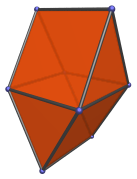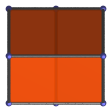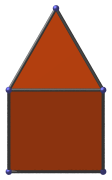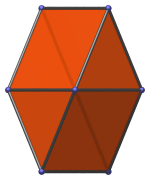The Gyrobifastigium
The gyrobifastigium (J26), also known by its Bowers Acronym gybef, is the 26th Johnson solid. It has 6 vertices, 14 edges, and 8 faces (4 triangles, 4 squares). It can be constructed gluing two triangular prisms together at their square faces in gyro orientation.

Its name comes from Latin fastigium, meaning roof
, referring
to the shape of a triangular prism resting on one of its square faces;
bi-, meaning two
; and the prefix gyro-, referring to
two pieces being joined together in gyrated orientation. Hence, the compound
gyro-bi-fastigium refers to the joining together in gyrated
orientation of two roof-like shapes (triangular prisms).
The gyrobifastigium may be considered as the digonal gyrobicupola, if we consider the triangular prism as a digonal cupola. This explains its placement as the 26th Johnson solid, the first among the bicupolae.
Projections
In order to be able to identify the gyrobifastigium in various projections of 4D objects, it is useful to know how it appears from various viewpoints. The following are some of the viewpoints that are commonly encountered:
| Projection | Envelope | Description |
|---|---|---|
 |
Square | Top view. |
 |
Pentagon | Side view. |
 |
Hexagon | Diagonal side view. |
Coordinates
The Cartesian coordinates of the gyrobifastigium, centered on the origin and with edge length 2, are:
- (±1, 0, √3)
- (±1, ±1, 0)
- (0, ±1, −√3)
Occurrences
In spite of its seemingly-odd shape, the gyrobifastigium in fact does occur as cells in a few non-trivial 4D CRF polytopes, such as the following:




